If any team can sum up the unpredictable nature of football, then it’s Leicester City.
Not many will have taken the 5000-1 odds of a Premier League victory for the Foxes back in 2016.
Likewise, they weren’t considered favourites for relegation to the EFL Championship last season.
However, after an inconsistent campaign last season, the former Premier League champions find themselves in the second tier of English football.
Leicester were among the bookie’s favourites for promotion this season, and in un-Leicester-like fashion, they are currently joint top leaders of the Championship, positioned as anticipated.
Despite a strong start, Enzo Maresca‘s side suffered a blip prior to the recent international break with back-to-back defeats against Leeds United and Middlesbrough.
The Northern outfits inflicted the Foxes’ second and third defeats of the campaign after Hull City got the better of Maresca’s side back in September.
In this Enzo Maresca tactical analysis and scout report, we will provide an analysis of Leicester’s dominant start to the season and the tactics deployed by Maresca.
We will further assess how the three aforementioned sides have emerged with victories over the East Midlands side, putting a dent into their promotion aspirations.
Setting the pace at the top
Leicester currently sits at the Championship, levelling on points with Ipswich Town.
The Foxes have been this season’s early pacesetters, having amassed 39 points to date this campaign.
Their start to this season has been made even more impressive when you factor in how the previous five title winners have fared at the same stage of the season.

The table shows that in the last five seasons, the eventual winners of the Championship did not have the same amount of points that Leicester have at the same stage.
Moreover, Leicester already have 10 points more than Burnley did after 16 games last season.
Furthermore, the average points per match for the total season points for these five teams is 2.07.
In comparison, Leicester currently have a points-per-match rate of 2.44.
If Leicester can continue with such form, they are projected to finish this season with 112 points.
To put into context, the current record holders for Championship points are Reading, who in the 2005/06 season topped the league with 106 points.
This is six points fewer than Leicester are projected to achieve at present.
Maresca’s side have certainly been dominant as they are joint-top of the possession rankings with Southampton, averaging 63.7% possession.
They are also joint-second for goals scored in the division with 29 goals.
Only league rivals Ipswich have scored more.
Furthermore, Leicester have only conceded 10 goals in the league so far, ensuring they have the tightest defence in the division.
Scoring goals aplenty and not shipping goals puts the East Midlands side in good stead for an immediate return to the Premier League.
Considering the only area of the pitch where Leicester has allowed their opponents to dominate possession by at least 55% is the Foxes attacking penalty area, football fans may be forgiven for thinking that stopping Leicester’s charge for promotion is an impossible task.
However, Maresca’s side have lost their last two matches and have lost three this season in the league, all by a single goal to nil.
Their two defeats from their last five matches represent a 1.8 points-per-match rate.
This is much lower than the overall 2.44 points-per-match rate previously alluded to.
Leicester have the second-highest expected goals per 90 rate of 1.7 in the league this season, yet in their two recent defeats, they only averaged 0.7 expected goals.
Moreover, in their 1-0 defeat to Hull, their expected goal tally was just 1.2.
But how did these sides frustrate such a dominant team like Leicester to claim all three points?
High press vs. deep build-up play
The summer transfer window brought upheaval in the East Midlands, losing key players such as James Maddison and Harvey Barnes.
However, Leicester managed to recruit players with Premier League experience, such as Harry Winks and Conor Coady.
One position that needed addressing was the goalkeeper role, and Marseca swiftly brought in Dane Mads Hermansen.
Hermansen was deemed a crucial acquisition due to his ability with the ball at his feet.
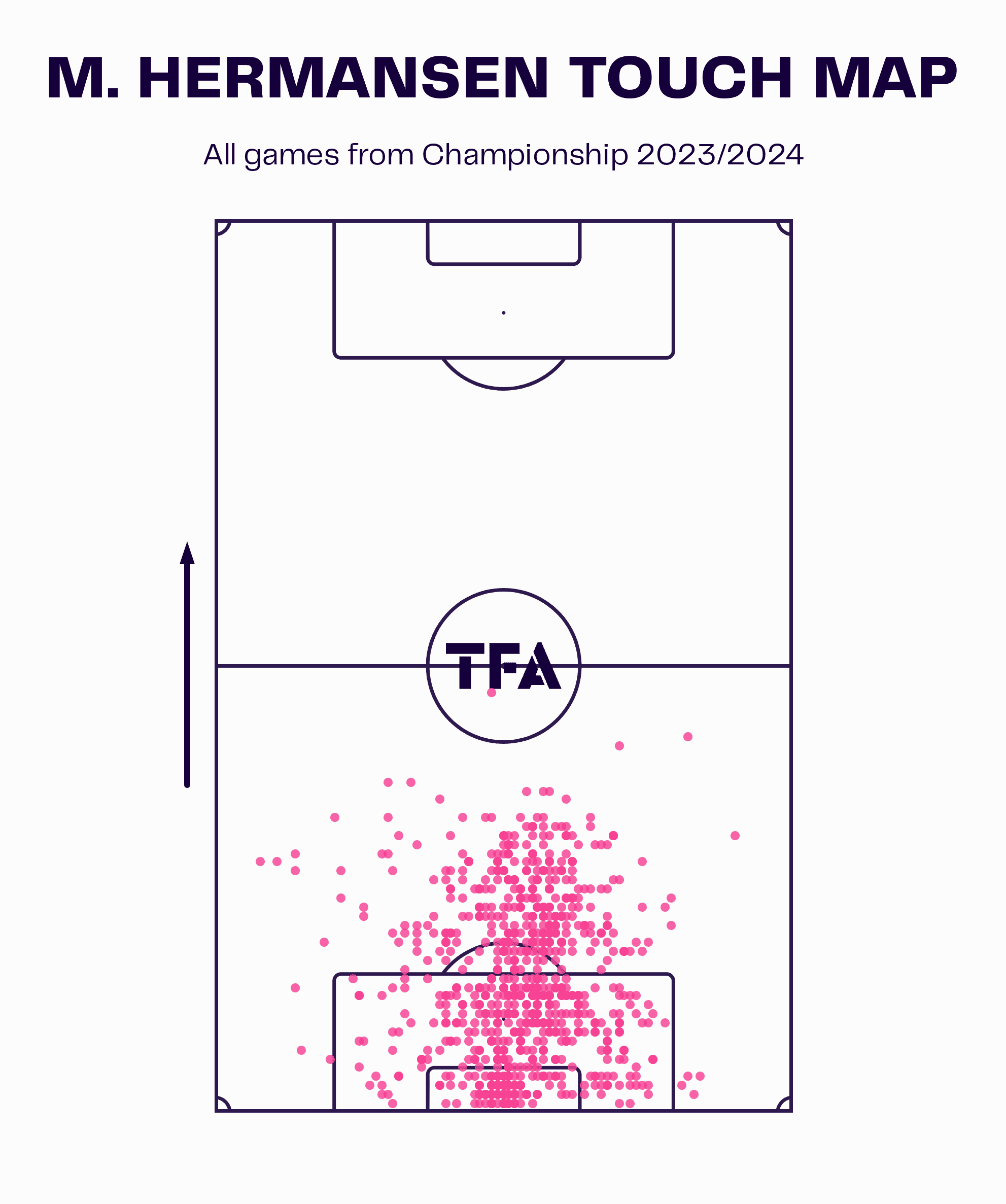
The graphic shows the touches by the keeper this season, and it is noticeable that he has often had possession of the ball far from his penalty box.
Leicester start their build-up play with Hermansen, and they rarely launch their goal kicks.
The average Leicester goal-kick length this season has been 30.8 yards.
Only Southampton have averaged a shorter distance.
Maresca lines his side up in a 4-3-3 formation, but their approach is fluid.
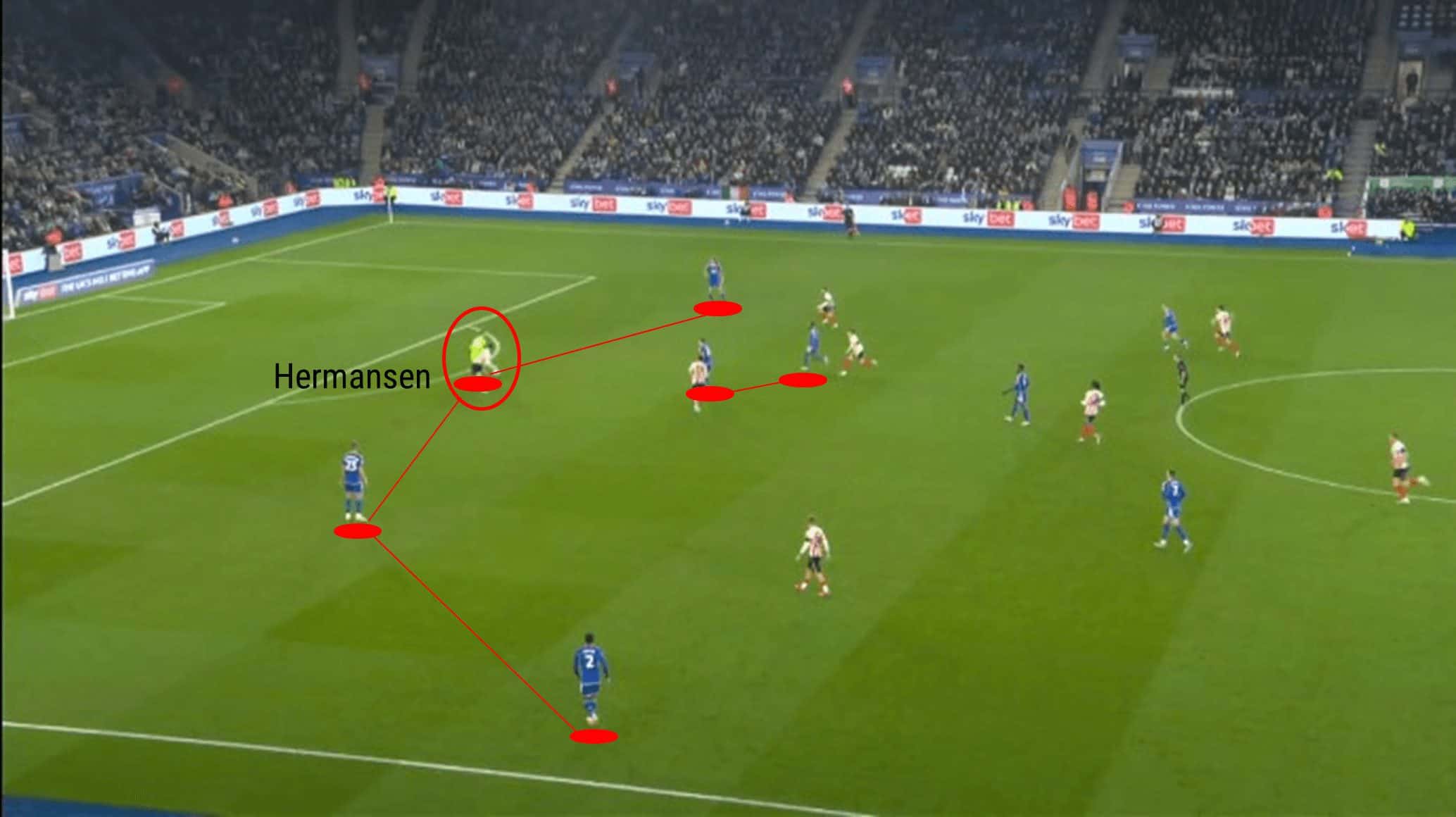
The traditional back four often spread the width of the pitch, facilitating space for Hermansen to progress with the ball.
The goalkeeper then forms a somewhat unconventional back four, as seen above.
As the defensive line disperses, licence for one of the full-backs is given to form part of a double pivot in midfield with Winks.
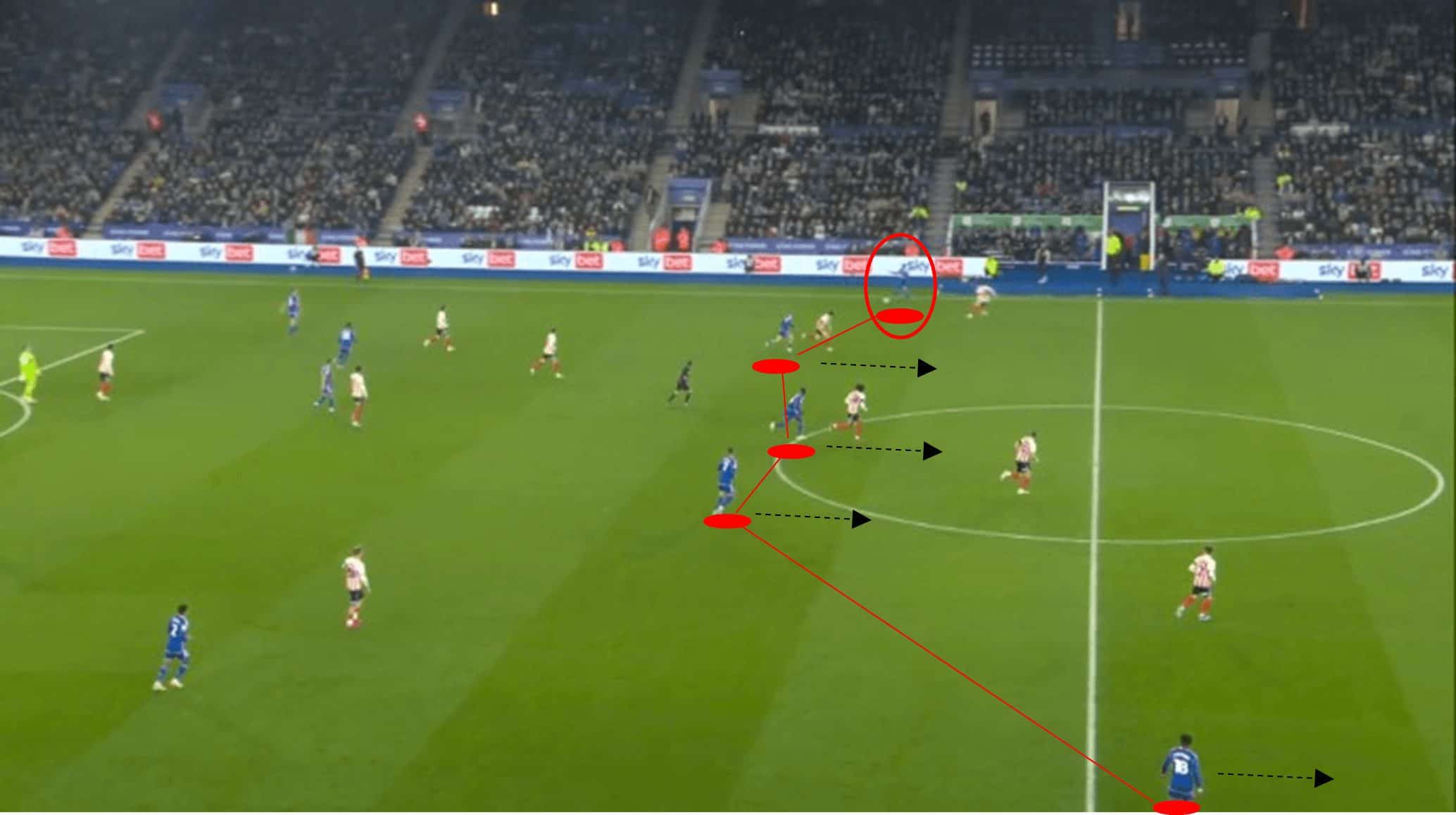
The double pivot in midfield allows the traditional number eight midfielders to get forward in support in the attacking phases of play.
Furthermore, Leicester often utilise the width of the pitch, as seen above.
Leicester are then able to attack with essentially five up front.
Leicester’s play from within their defensive third to be able then to commit half of their outfield options to their attack suggests why they are one of the division’s top scorers.
The Leicester squad possesses plenty of quality, and they are often patient in such build-up play.
The Foxes average 4.98 passes per sequence and have completed 330 10-plus sequences, the highest in the league.
They have completed 81 build-up attacks this season, also the most in the league.
However, despite topping the charts for their possession-based style of play, their patient build-up play is their downfall and their opposition has exploited this.
Leicester progress the ball only 1.56 metres/second, and only Watford and Swansea progress the ball at a slower rate.
The Foxes are, therefore, vulnerable to a high press.
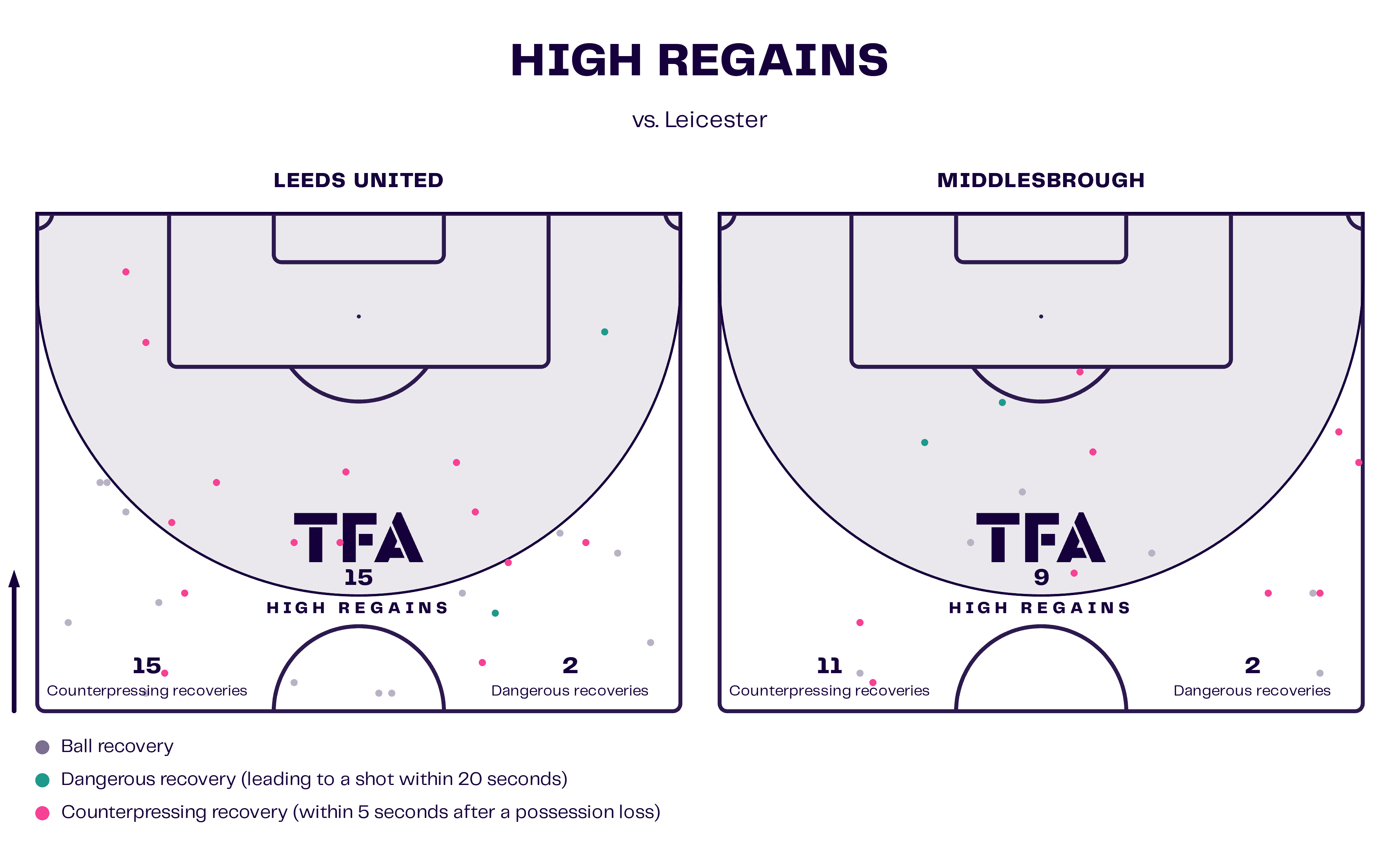
The graphic shows the high number of high regains and counterpressing recoveries by Leeds and Boro from their respective victories over Leicester.
Daniel Farke’s side was particularly effective at recovering the ball from all channels of the pitch.
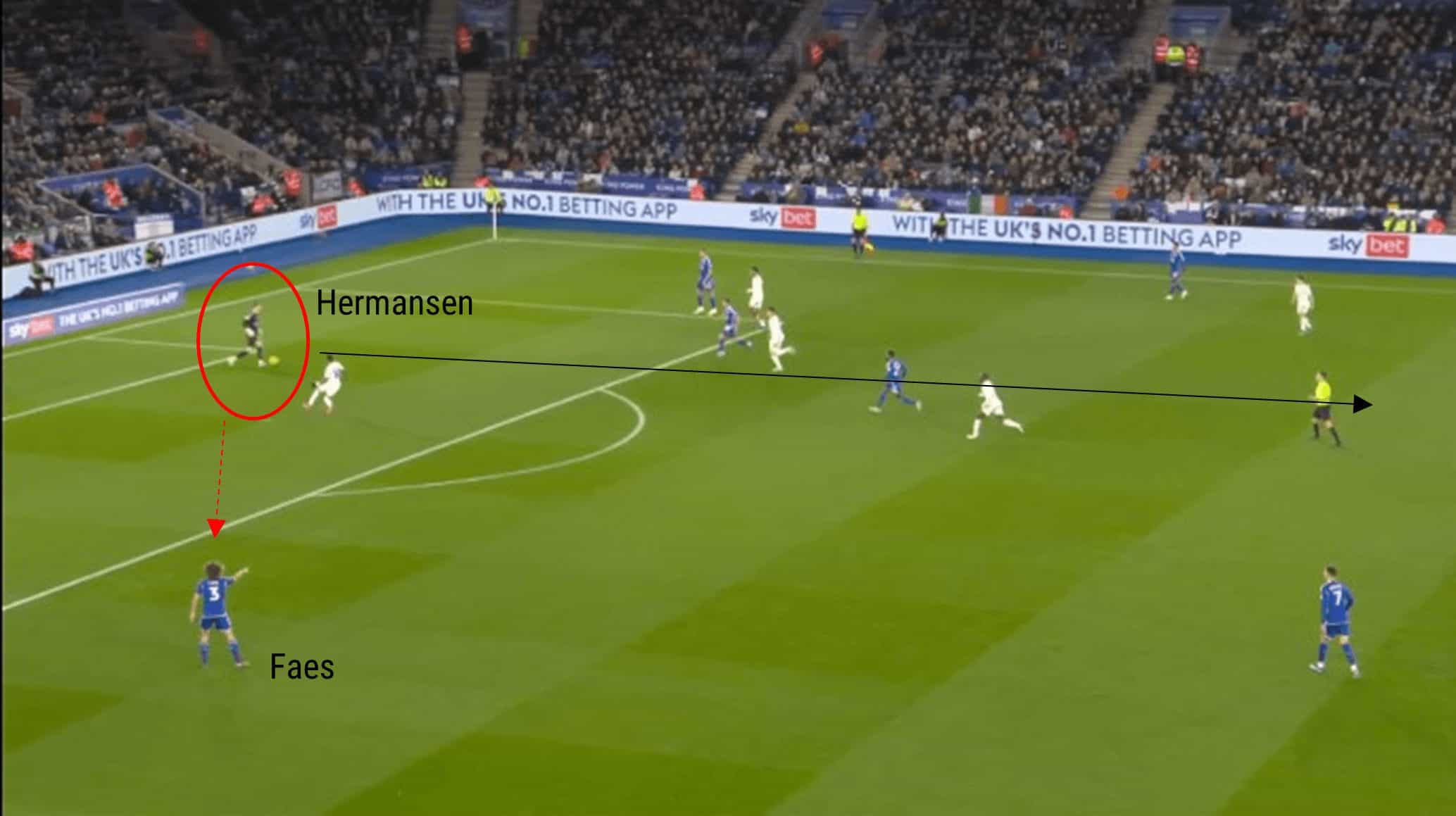
In the above image, Leeds adopts a high press to limit Hermansen’s passing options.
The positioning of the Leeds forward ensures the Danish keeper is unable to opt to play the ball out wide to Wout Faes.
With limited options due to a man-marking press, the keeper plays the ball into a dangerous, congested area of the pitch.
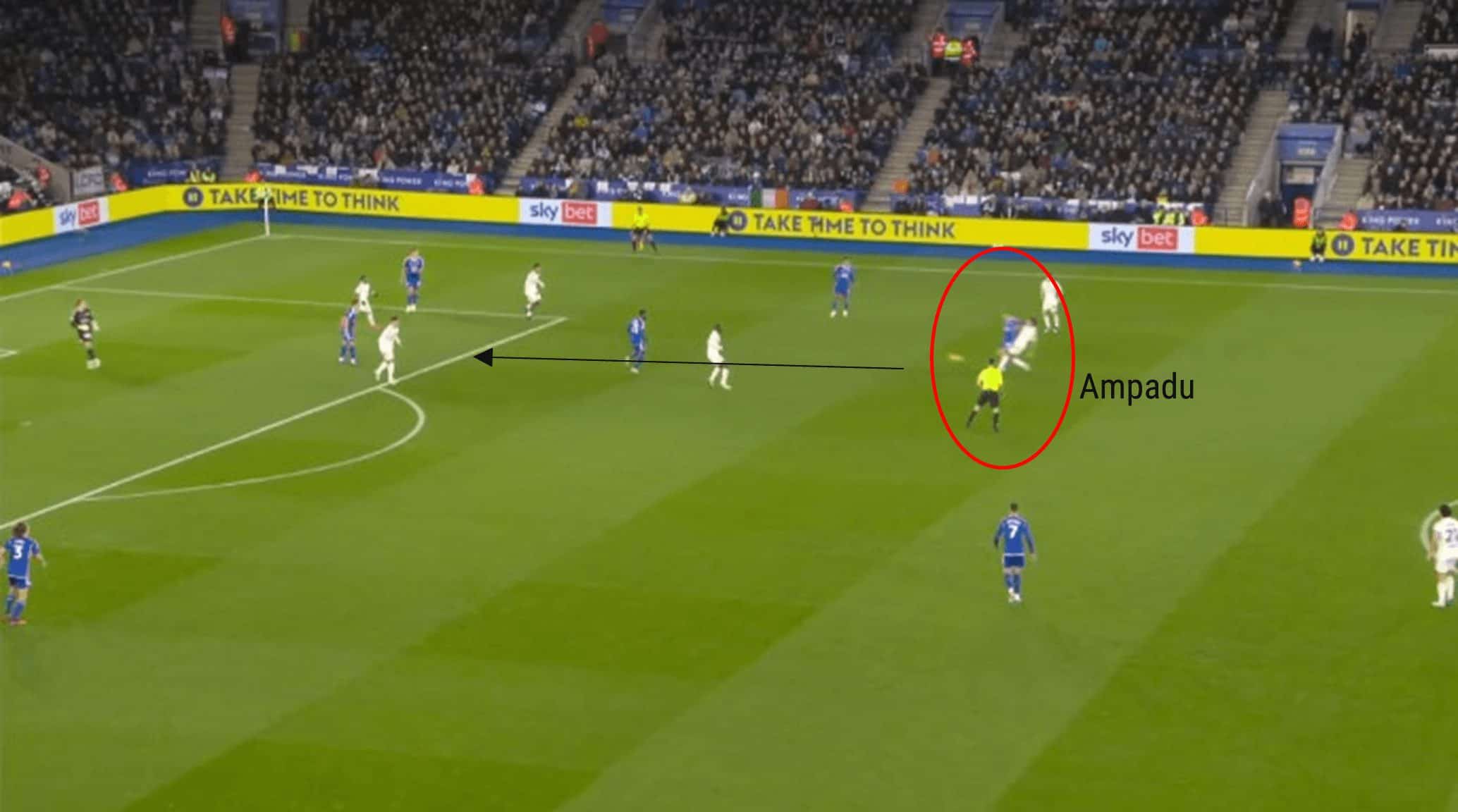
Leeds’ Ethan Ampadu is able to intercept the pass.
Leeds quickly switch to an attacking phase, passing towards Georginio Rutter.
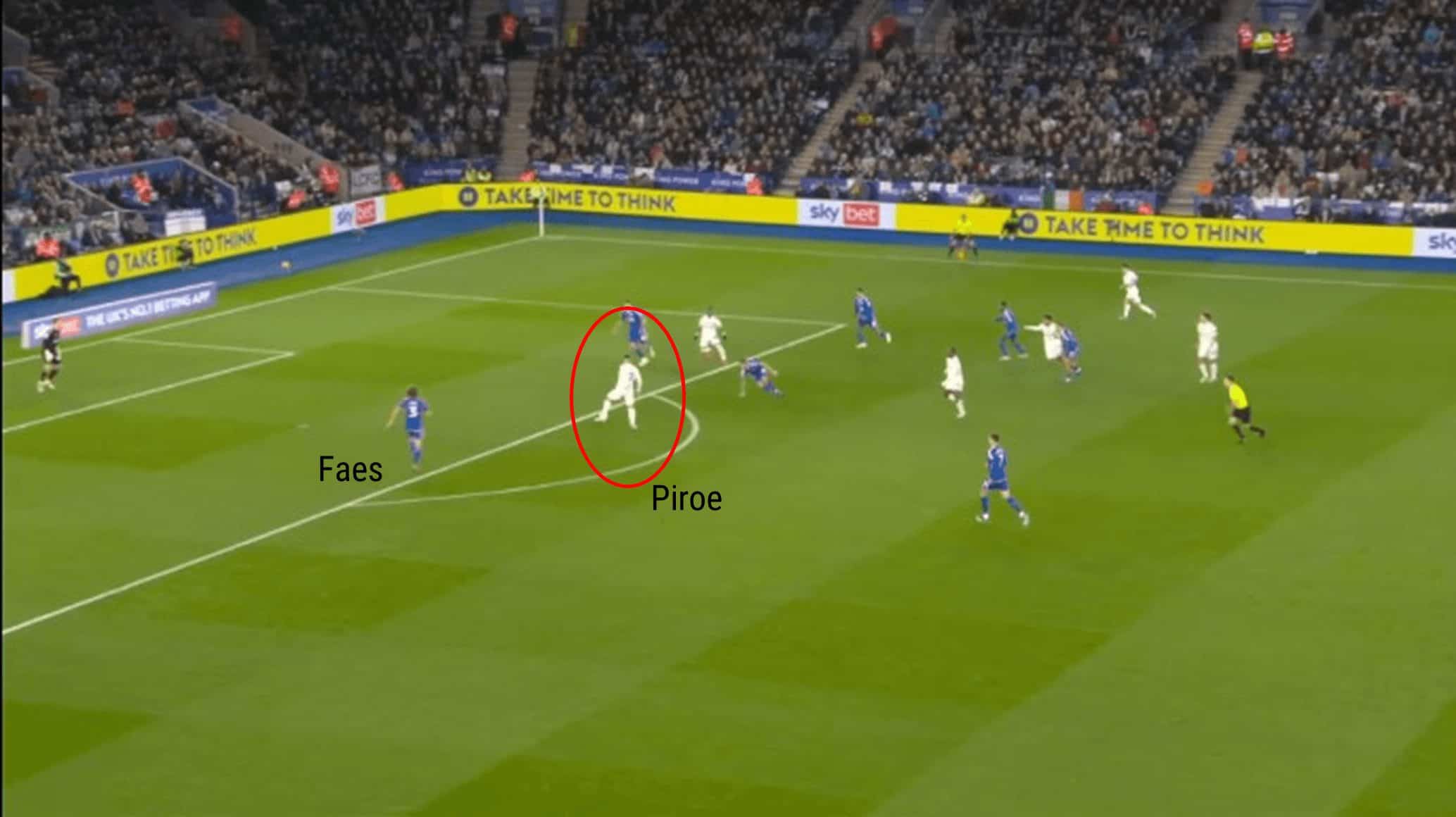
The ball is eventually played toward Joel Piroe, forcing Faes to come back to defend quickly.
However, the former Swansea forward is unable to get his shot on target.
Although Leeds didn’t score in this instance, it is demonstrated how effective the high press can be against the Foxes.
Whilst Leeds’s PPDA value is 11.2, the third lowest of the division, suggesting they are accustomed to such high pressing, the same can’t be said for Liam Rosenior’s Hull side.
The Tigers have the third-highest PPDA value of 16.2.
Nevertheless, Hull effectively pressed against Leicester.
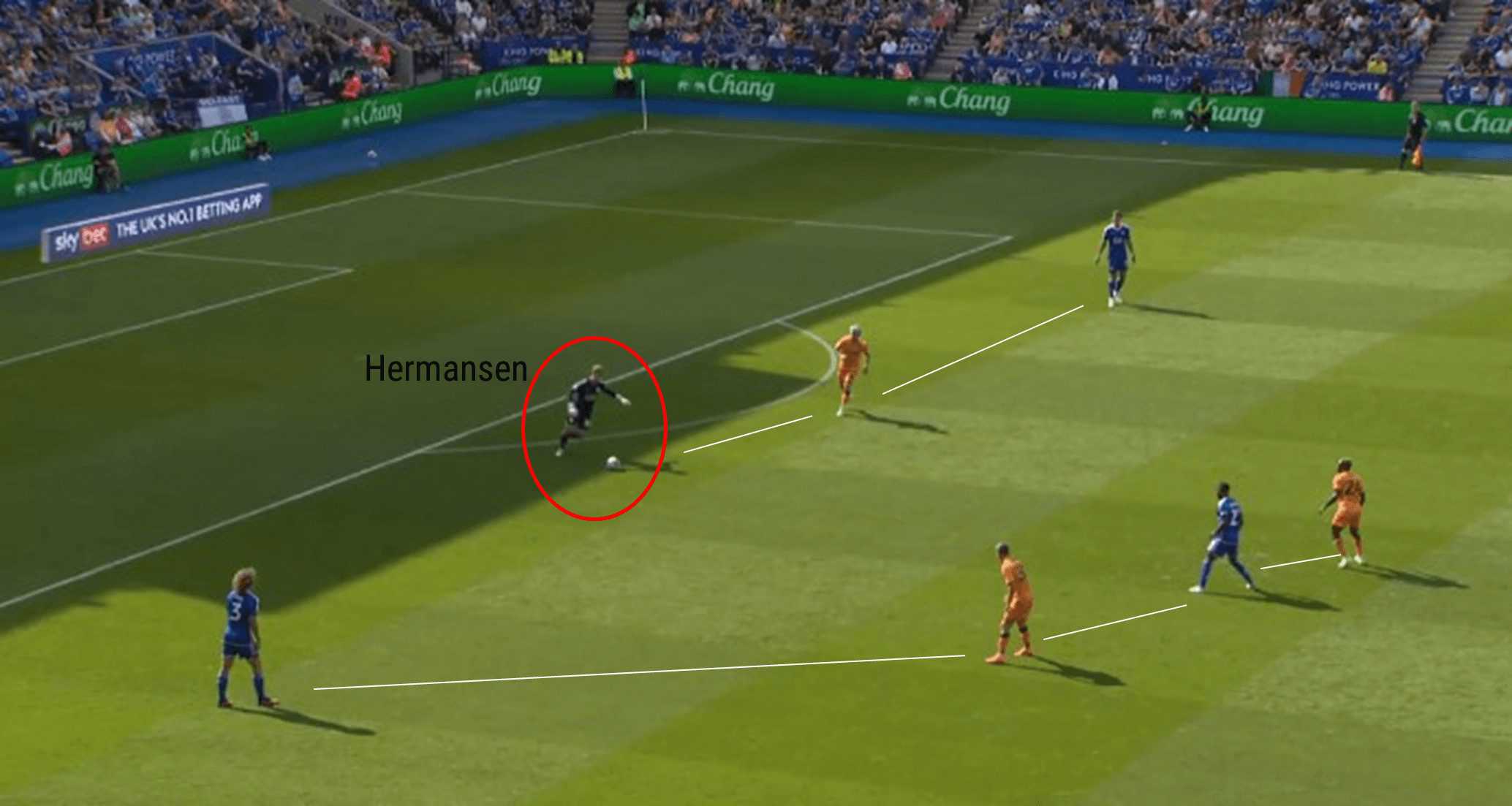
Hull have committed players forward, restricting the options across the defensive line for Hermansen to initiate Leicester’s build-up play.
Whilst Rosenior’s side didn’t regain the ball high as the result of the press, they did regain possession in their own half as Hermansen was forced to distribute the ball long and, subsequently, lost possession.
Although Hermansen is comfortable with the ball at his feet, he has only successfully completed 32.8% of his passes, which he has launched longer than 40 yards.
If teams are to continue to adopt a high press, the Danes’ distribution will be crucial in allowing his side to progress and will need to improve in order to bypass such a press.
Man-marking key players
A key player in Leicester’s attacking phase of play is forward Kelechi Iheanacho.
The former Manchester City forward often looks to drop deep to aid in distributing the ball out wide.
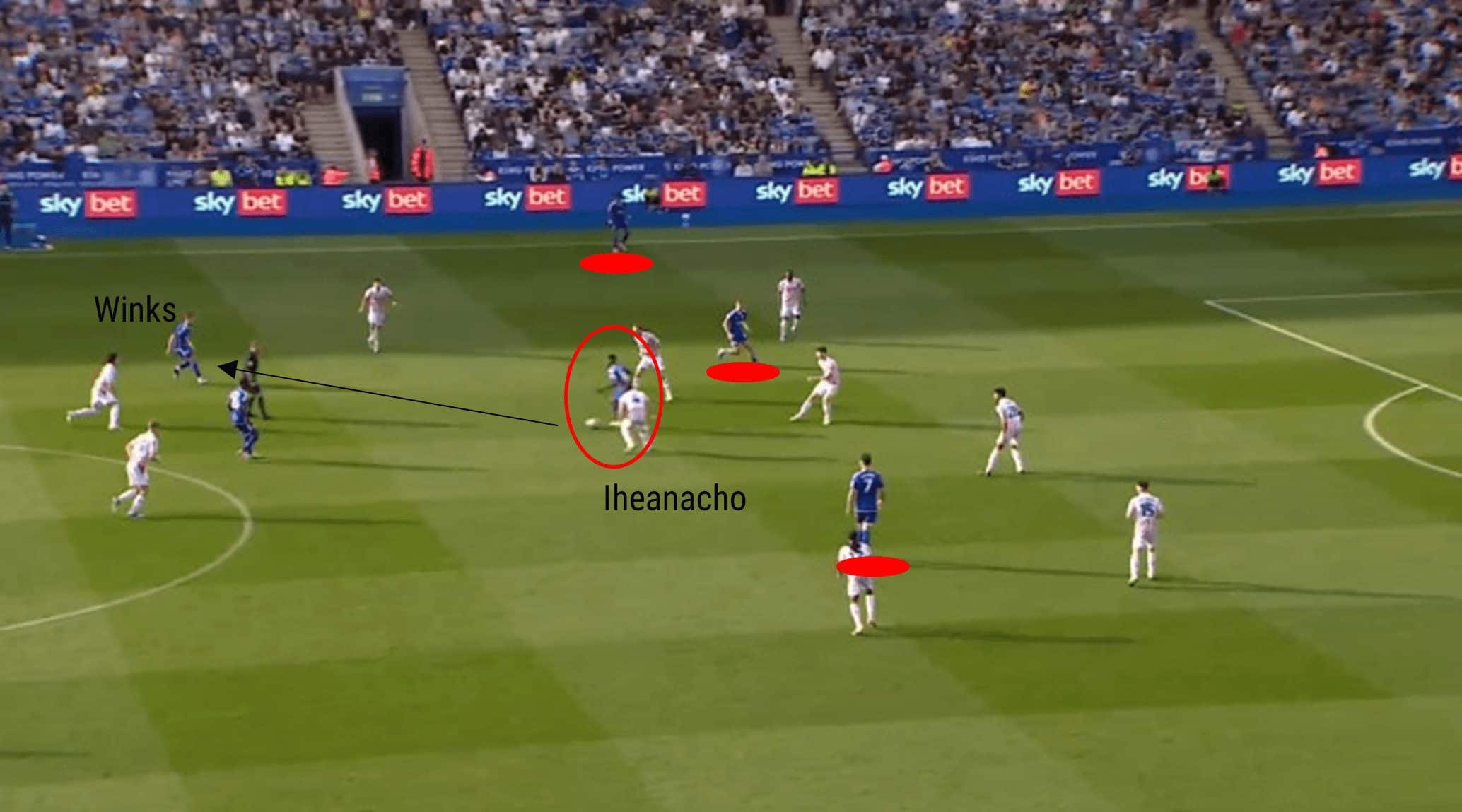
Iheanacho is seen dropping deeper, finding a pocket of space to pass the ball back to the deep-lying midfielder, Winks.
As Iheanacho drops deep, three Leicester players stay higher up in the attacking third.
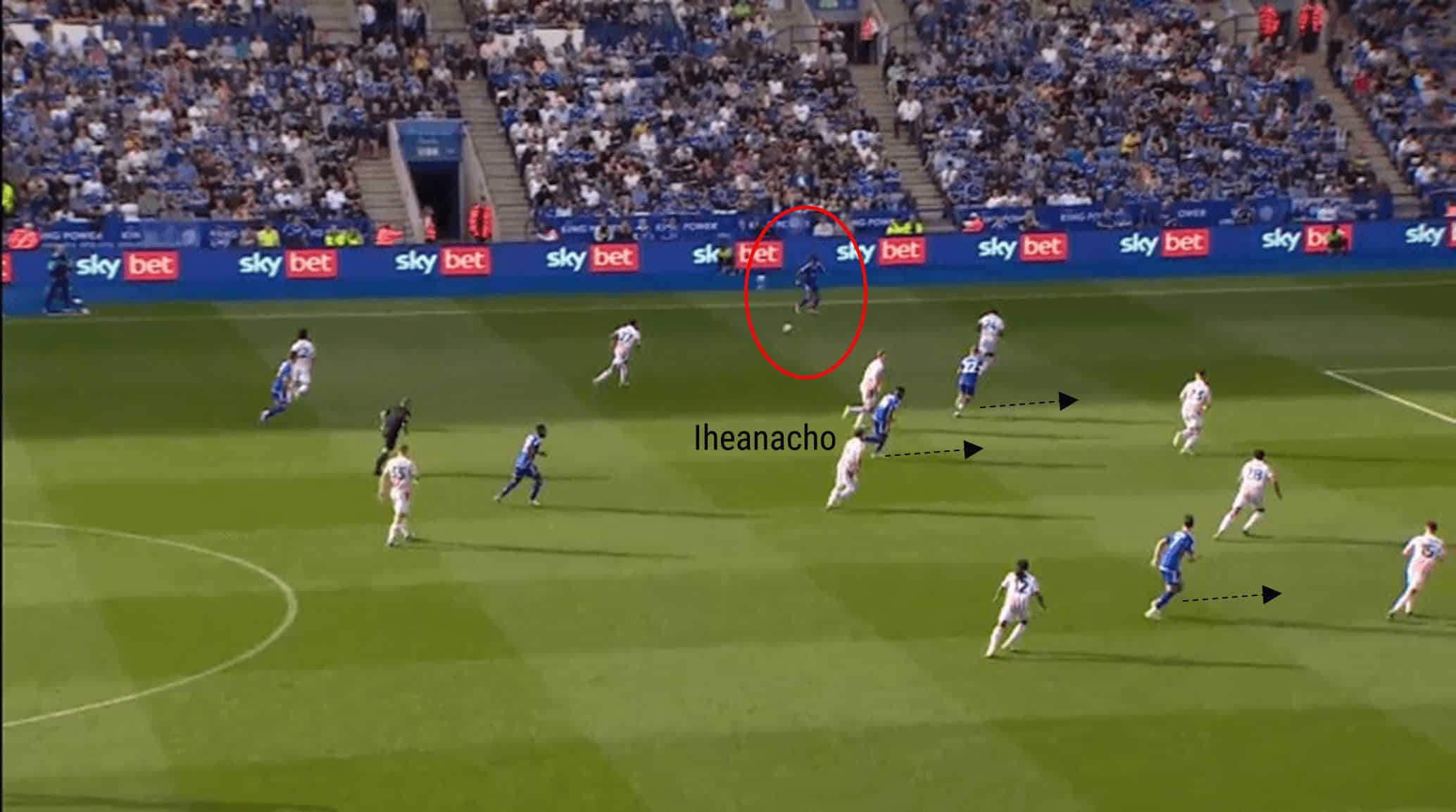
Winks immediately plays the ball to the left wing.
The Nigerian forward is then seen quickly turning to run towards the penalty area to join the attack with the two advanced midfielders, Kiernan Dewsbury-Hall and Cesare Casadei.
Middlesbrough identified the threat that Iheanacho possessed and subsequently opted to deploy their central defender, Dael Fry, to man-mark the forward throughout their match.
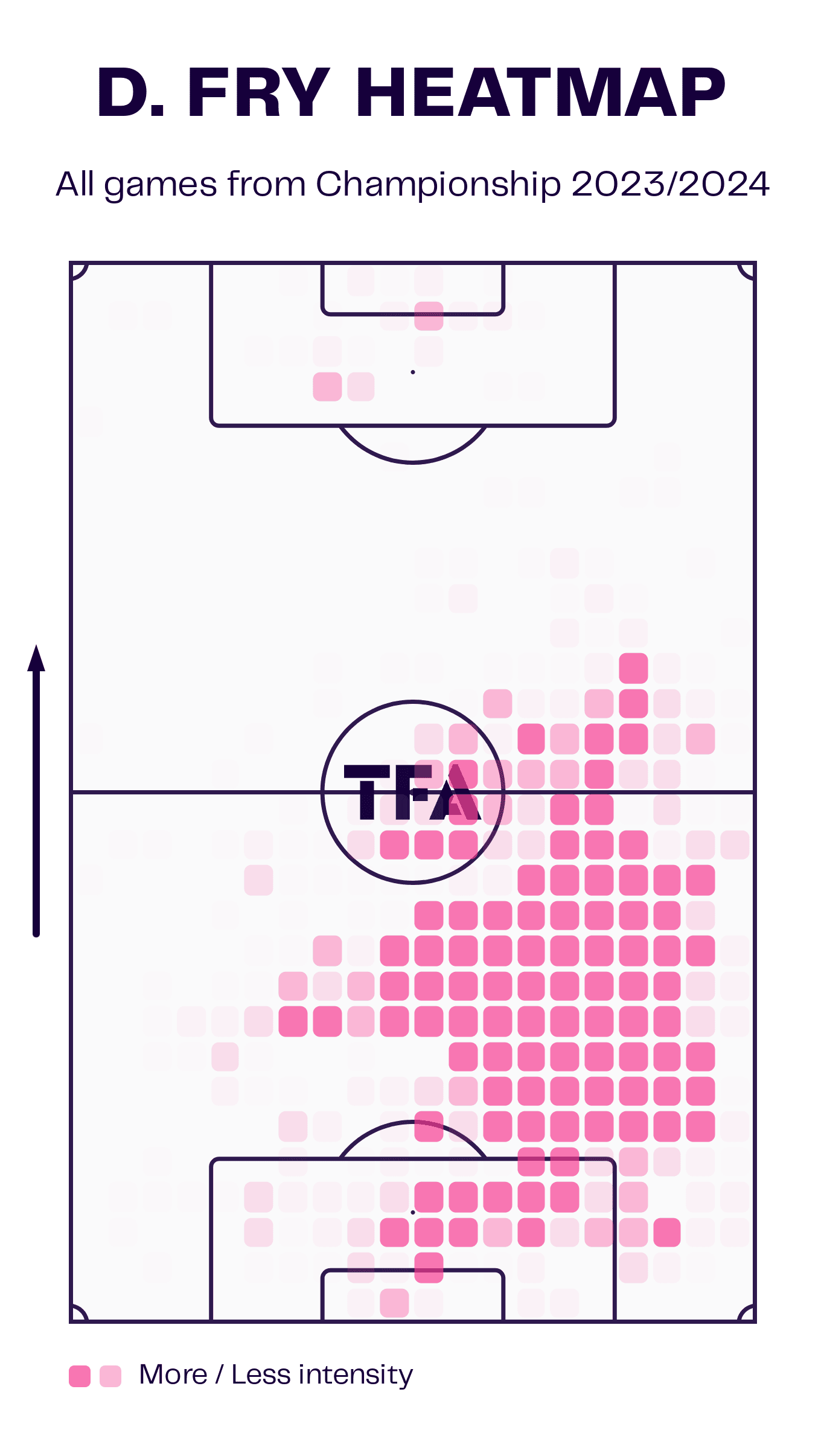
The graphic shows that Fry has often occupied the right-hand side of central defence, rarely venturing into the attacking third.
However, Fry’s role against Leicester put the defender in uncharted territory.
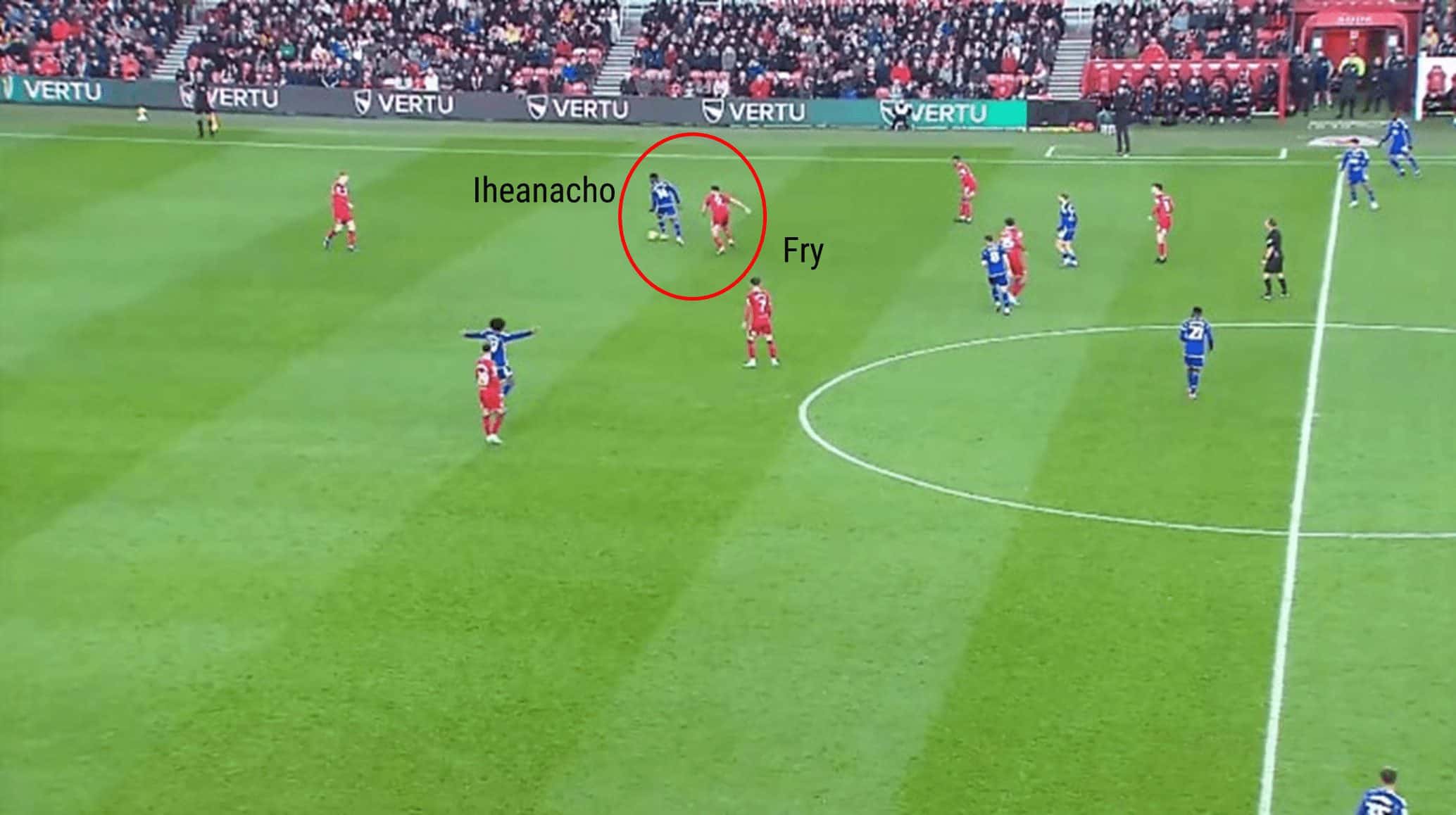
Fry is positioned very advanced, with only his striker teammate, Josh Coburn, more advanced.
It is noticeable here that Fry’s constant presence around the Nigerian has impacted Leicester’s play, as Iheanacho is in possession within his own half.
He does not have the option to lay the ball off into the midfield and utilise the width of the pitch.
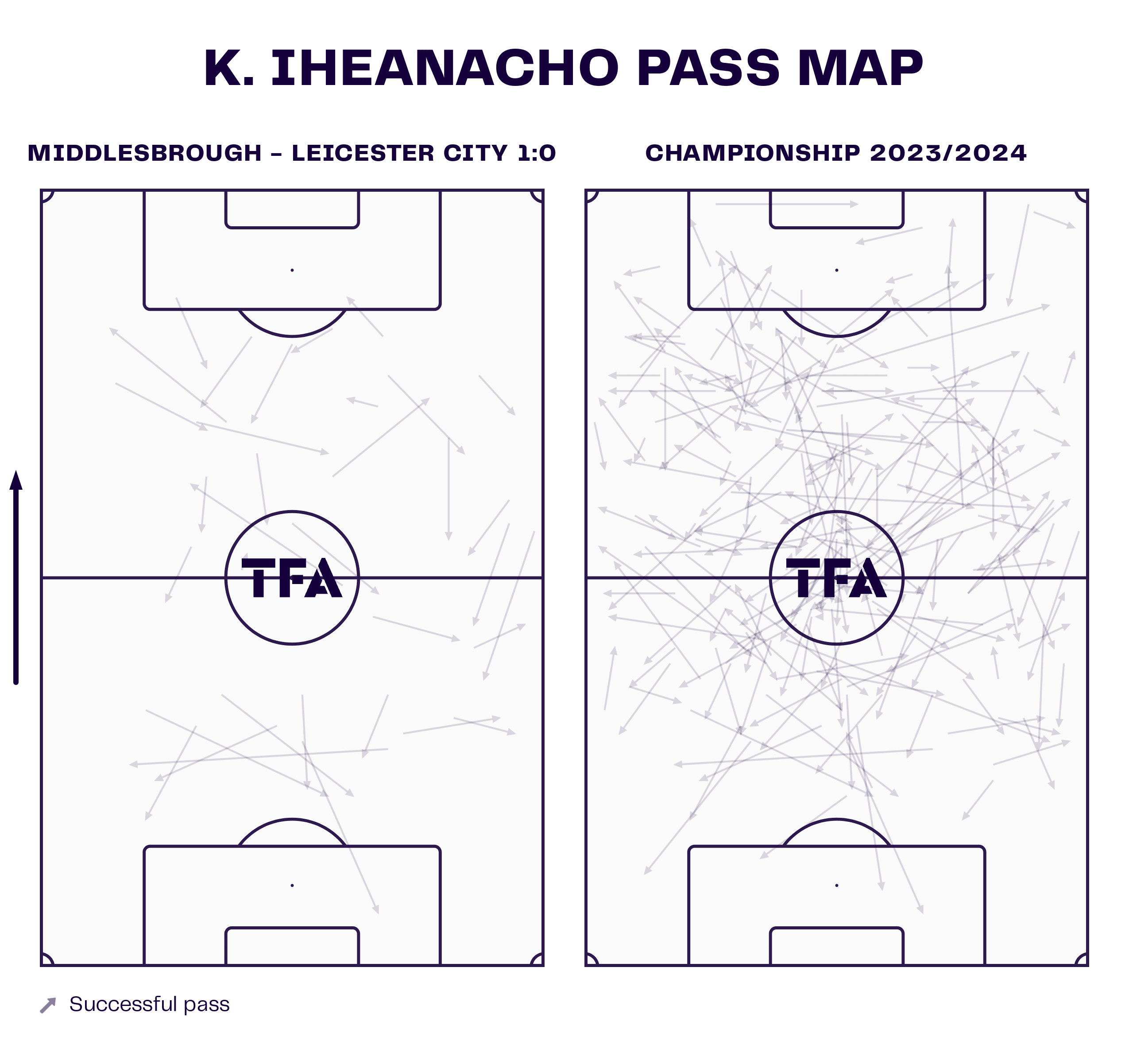
Iheanacho often found himself having to go deep in order to have any impact on the game due to the man-marking strategy.
The graphic shows that the passes made by the former Manchester City forward in his defensive third against Boro accounted for around 50% of his total passes in the defensive third all season.
Such passing in the defensive third often played back to the goalkeeper, ensured that Iheanacho’s possession was ineffective and nullified his threat on the game.
Hull also used the tactics to man-mark Iheanacho.
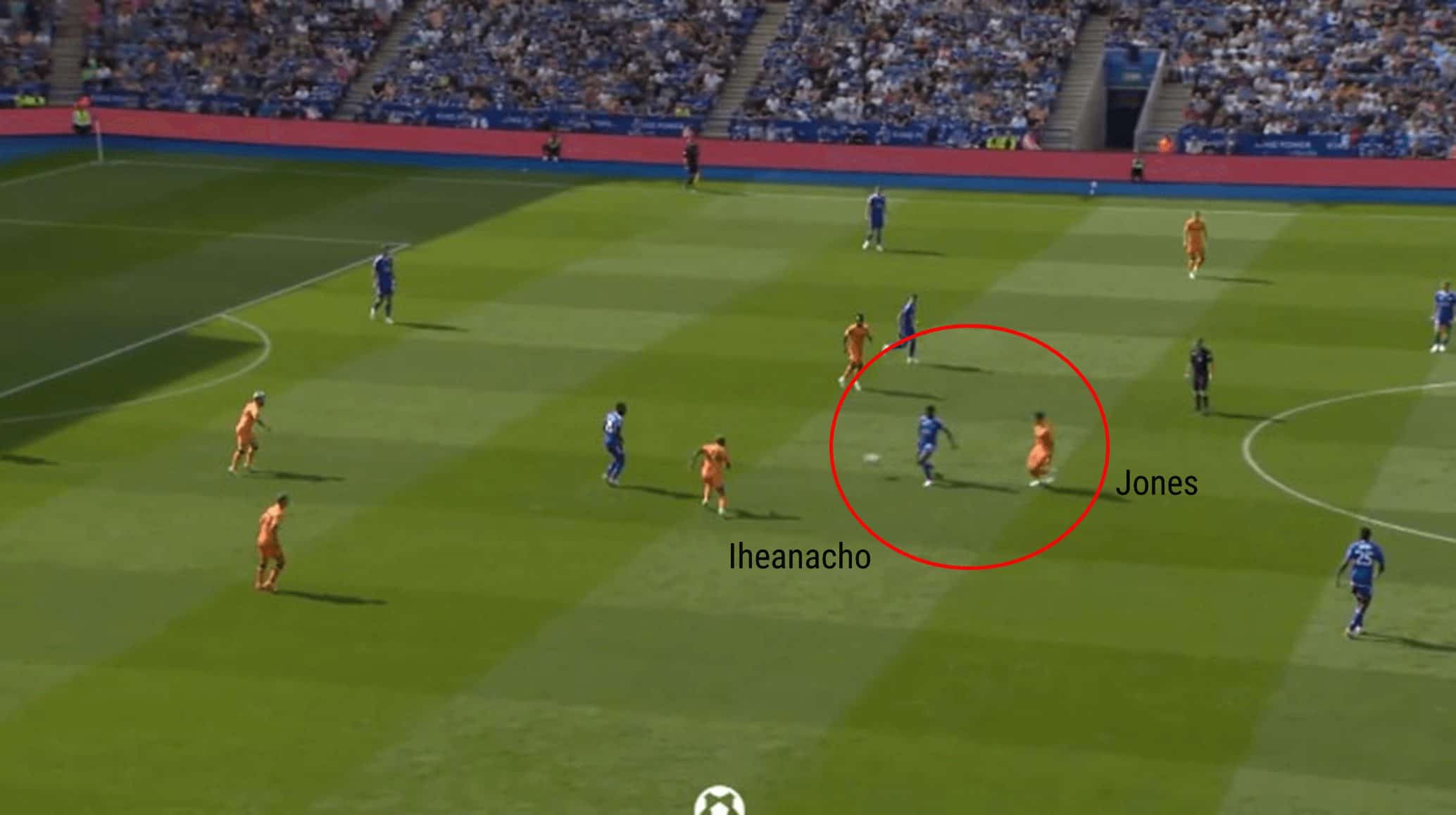
Hull’s Alfie Jones was given the task to nullify the threat of Iheanacho.
The image shows how deep Iheanacho was forced to retreat to try and impose himself in the game.
Hull’s tactics ensured a quiet afternoon for the Nigerian, and he was substituted in the 68th minute for Jamie Vardy.
The substitution was a case of like-for-like, and Maresca did at least change the system against Boro, introducing two upfront when Iheancho was marked out of the game.
However, the Italian arguably made the change too late in the game in the 85th minute, after Middlesbrough had just scored.
With such little time remaining, it was difficult for Leicester’s change of tact to be influential.
Importantly for Boro, when Fry did mark Iheanacho within the Leicester half, Boro ensured they did not leave space in their backline.
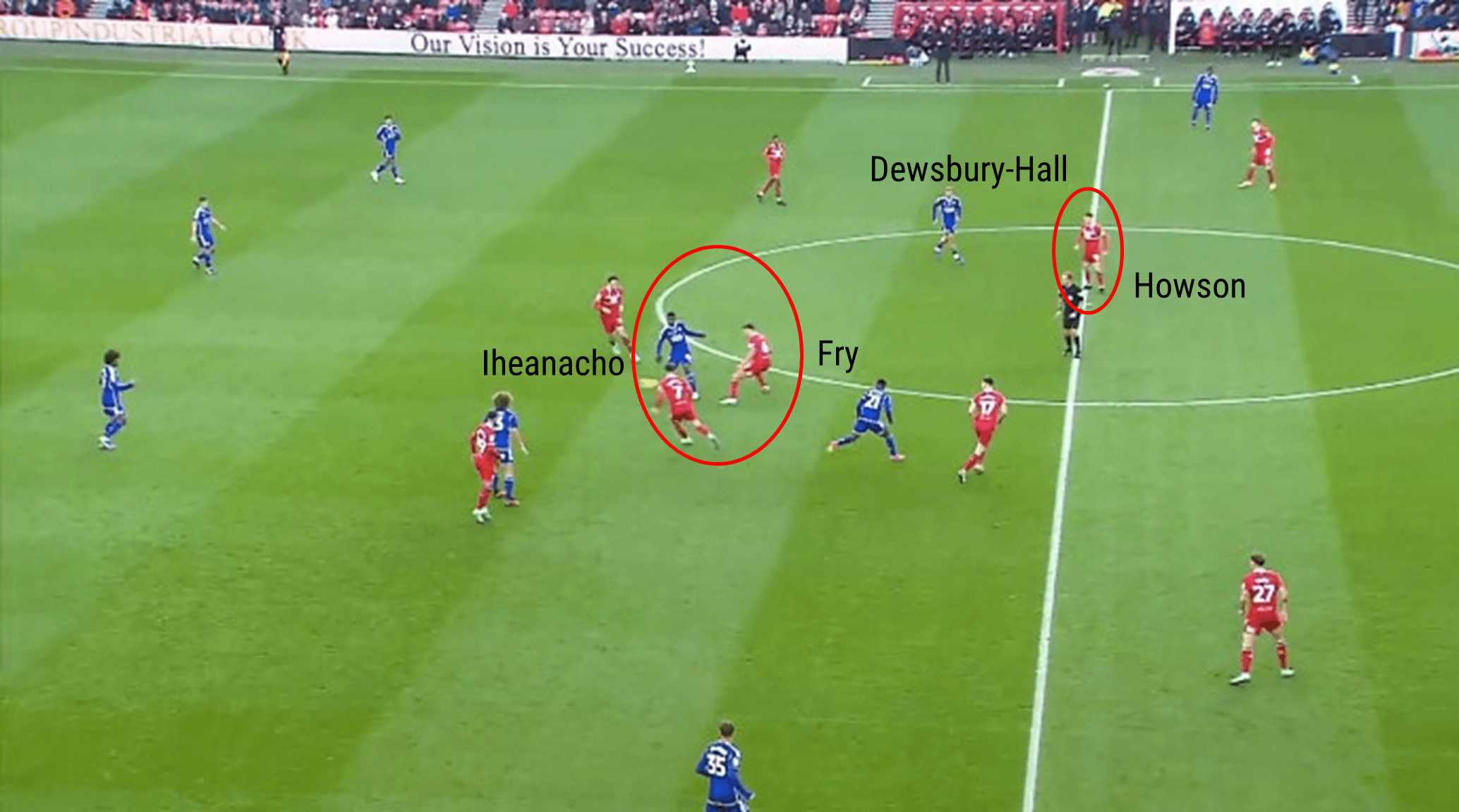
Jonny Howson retreated back from his usual defensive midfield position to occupy the space on the right side of defence left by Fry.
The positional change also ensured Howson could keep tabs on his target man, Dewsbury-Hall.
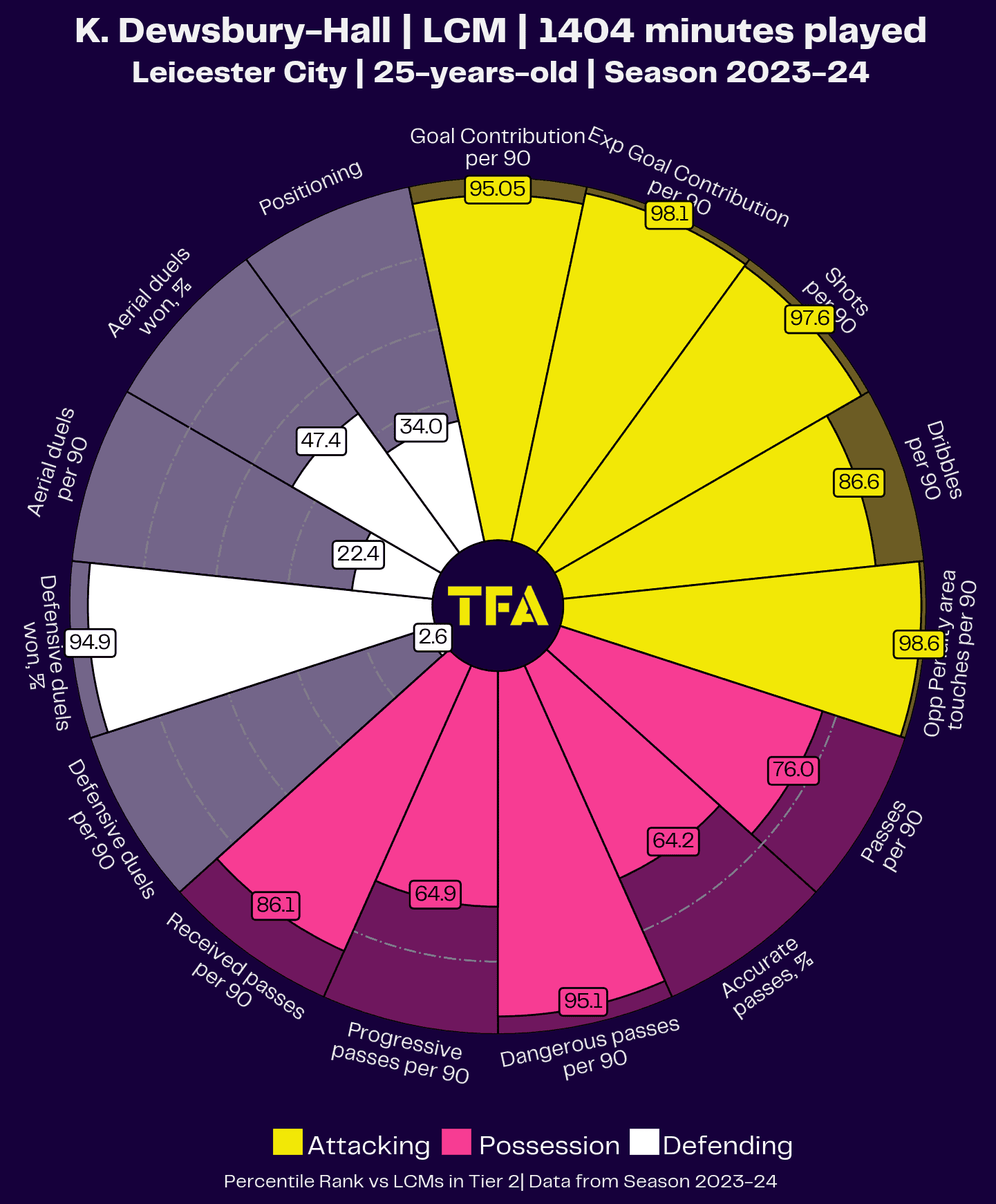
The pizza plot shows how Dewsbury-Hall has ranked highly for his attacking and possessional play this season.
Moreover, it shows how influential Dewsbury-Hall has been for Leicester this campaign.
It suggests his importance to Leicester’s overall play.
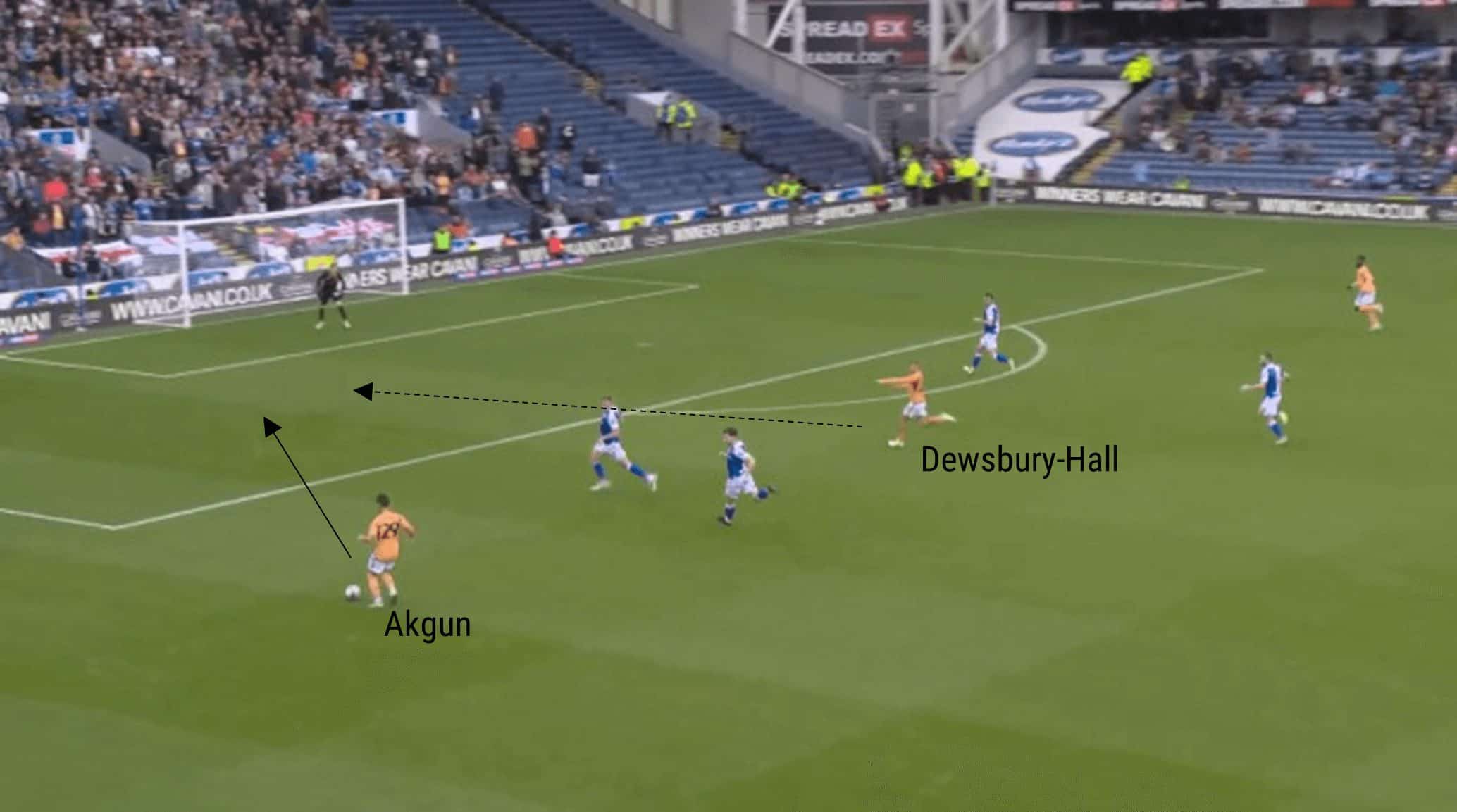
The midfielder has shown his intelligent off-the-ball movement here, instructing his teammate to pass into the penalty area.
The midfielder has also run into space to bypass four Blackburn players.
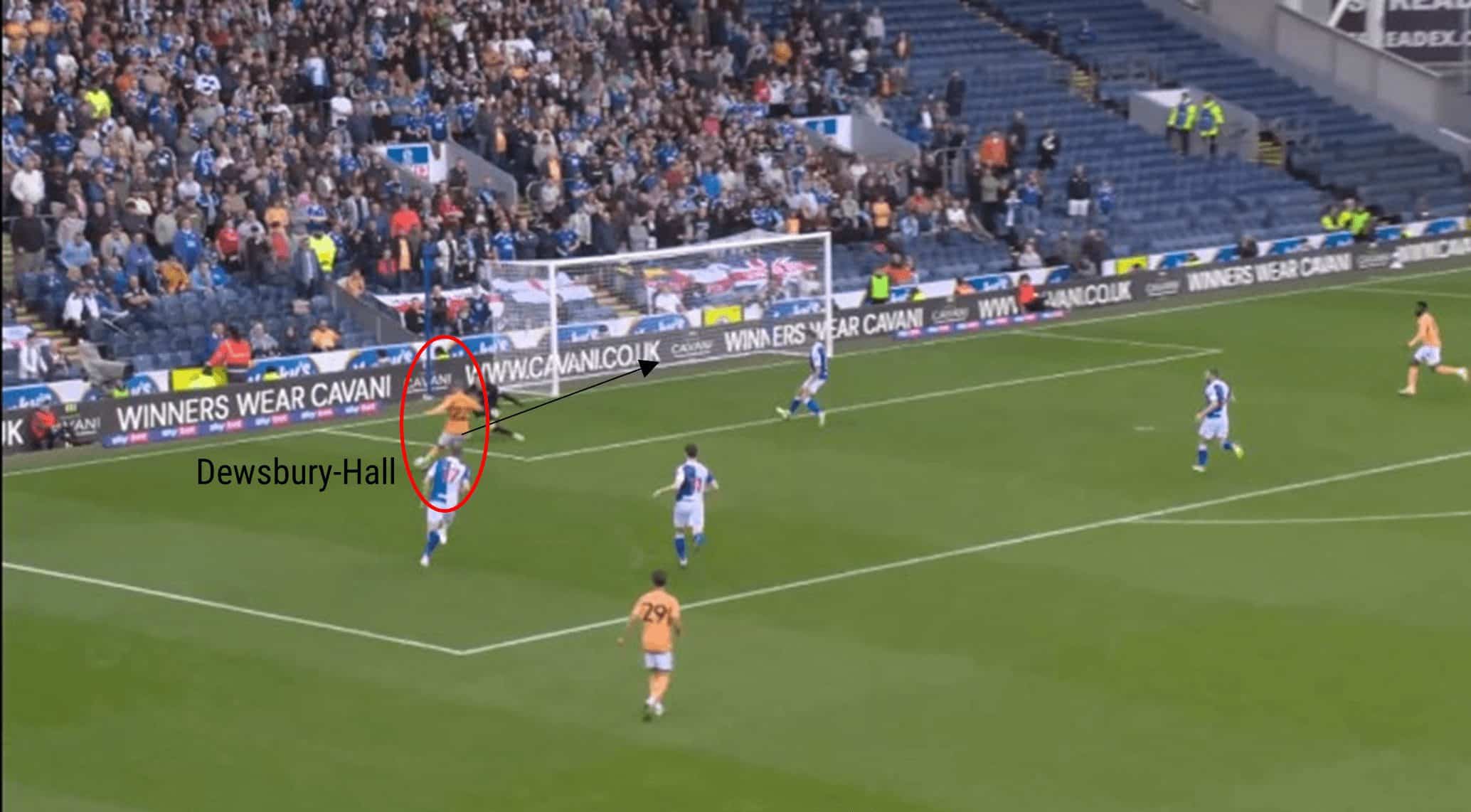
Dewsbury-Hall is able to get on the end of the pass and score from an acute angle.
This particular goal had an expected goal value of 0.18, demonstrating the quality of the Leicester player to dispatch the effort.
The decision by Michael Carrick to instruct Howson to mark the midfielder out of the game seemed an instrumental decision.

Dewsbury-Hall has had to come deep within his own half but is restricted by Howson’s presence to advance the play down the channel.
Moreover, Middlesbrough’s high press has ensured that recycling the ball across the backline would be risky.
The more obvious pass is towards Iheanacho, but he is being man-marked by Fry.
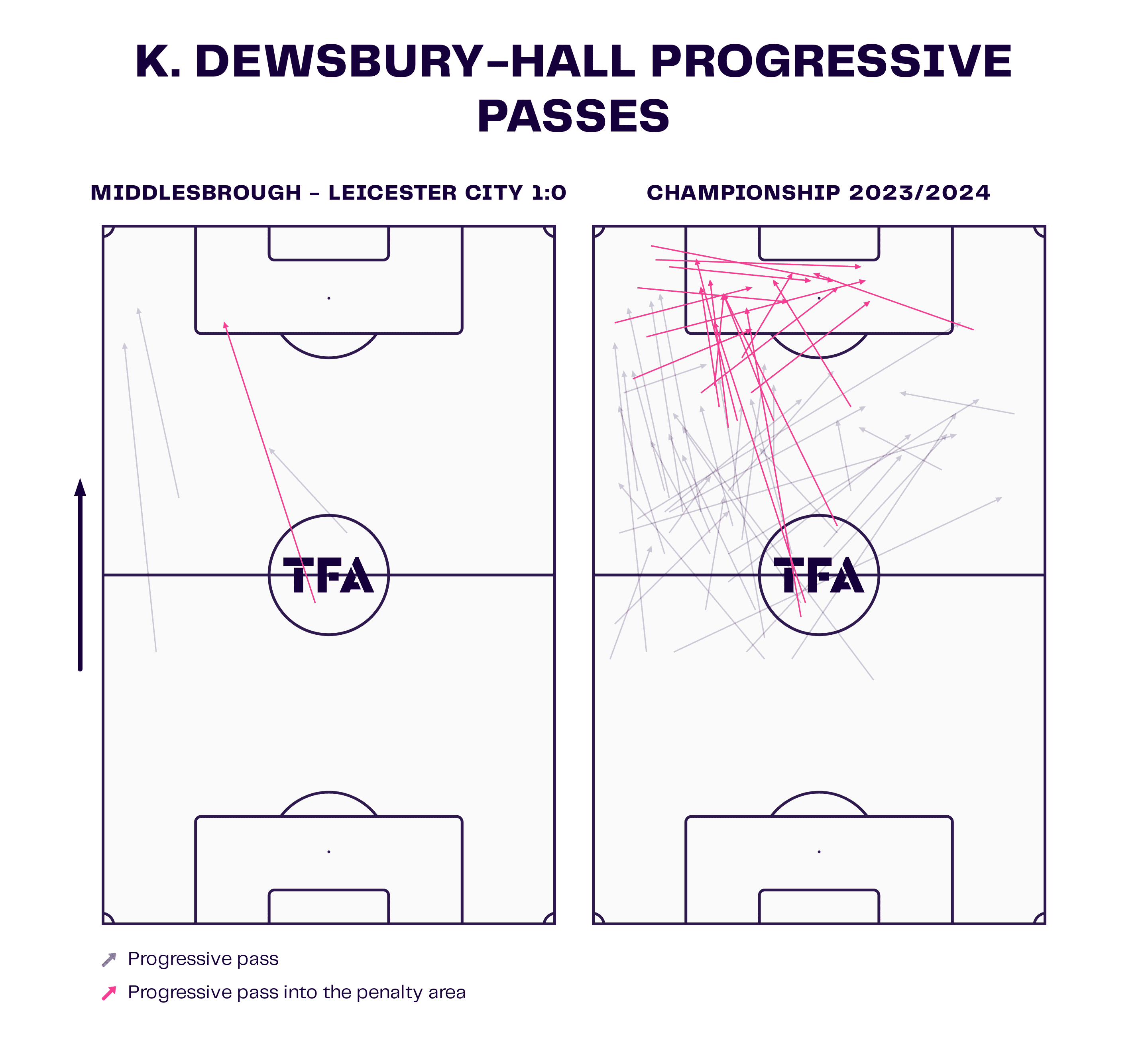
Howson’s man-marking of Dewsbury-Hall ensured he had less of an impact in the match.
Dewsbury-Hall averages 7.12 progressive passes per 90, but the graphic shows he made less than this average against Boro.
It is noticeable that while Dewsbury-Hall could make passes into the left channel, he didn’t successfully pass across into the penalty area as he often looks to do.
Middlesbrough nullified the East Midlands side’s attacking threat by squashing the threat of Leicester’s most influential players.
Maresca will likely need to adapt as the season progresses in case more teams follow suit.
Conclusion
In this tactical analysis and scout report, we have highlighted Leicester’s impressive start to life back in the Championship and how they are on course to break the record books.
We have analysed Leicester’s tactics, showing their build-up play from the back and their successful transitions from defence to attack.
This analysis has also demonstrated, though, that Leicester’s preferred build-up play has come at a cost, with teams adopting a high press to halt their transitions of play through the thirds of the pitch.
Furthermore, it has been highlighted how important Iheanacho and Dewsbury-Hall have been to Maresca’s side, and by man-marking the key players, opposition teams have profited.
Going forward, Leicester will need to have ready solutions if such tactics are to be used against them again this season.
It could be the difference between clinching promotion or succumbing to a second season in the second tier.






Comments